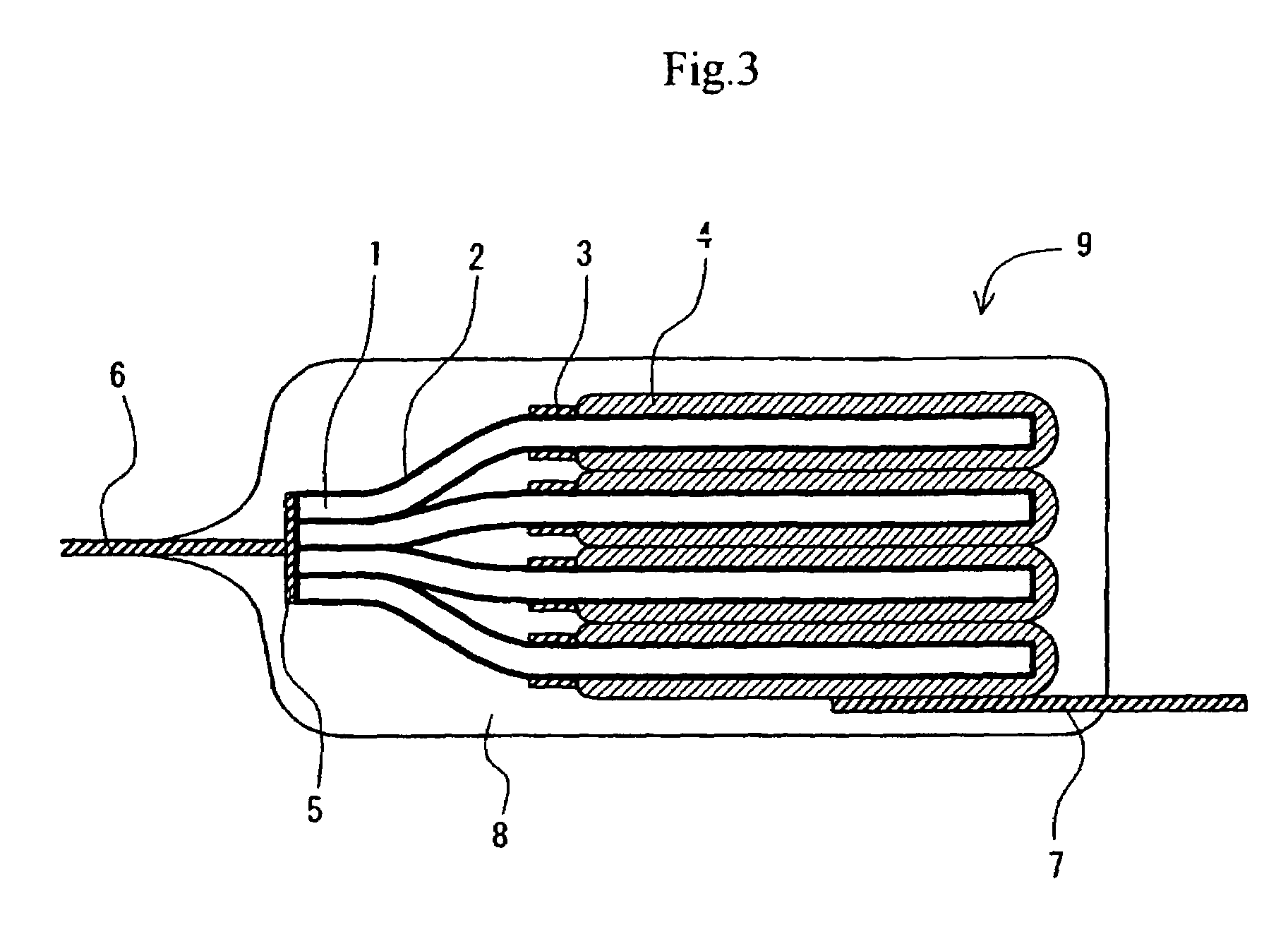Solid electrolytic capacitor and method for producing the same
a solid electrolytic capacitor and electrolytic capacitor technology, applied in the manufacture of electrolytic capacitors, variable capacitors, fixed capacitors, etc., can solve the problems of increasing the leakage current, uneven thickness of electrically conducting polymers attached, and the inability to achieve desirable capacitance of solid electrolytic capacitors, etc., to achieve the improvement of one-dimensional properties of polymer chains, improve the effect of capacitor properties and increase the electrical conductivity
- Summary
- Abstract
- Description
- Claims
- Application Information
AI Technical Summary
Benefits of technology
Problems solved by technology
Method used
Image
Examples
example 1
[0115]A formed aluminum foil (thickness: 100 μm) was cut into a size of 3 mm (short axis direction)×10 mm (long axis direction) and a polyimide solution was circumferentially coated on both surfaces to a width of 1 mm to section the surface area into a 4-mm portion and a 5-mm portion in the long axis direction, and then dried to form a masking. The 3 mm×4 mm portion of this formed foil was electrochemically formed with an aqueous 10 mass % ammonium adipate solution by applying a voltage of 4 V to form an oxide dielectric film on the cut end part. Thereafter, this 3 mm×4 mm portion of the aluminum foil was dipped in 1.2 mol / L of an isopropyl alcohol (IPA) solution having dissolved therein 3,4-ethylenedioxythiophene for 5 seconds, dried at room temperature for 5 minutes, and then dipped for 5 seconds in 2 mol / L of an aqueous ammonium persulfate solution containing sodium 2-anthraquinonesulfonate adjusted to a concentration of 0.07 mass %. Subsequently, this aluminum foil was left stan...
examples 2 (
EXAMPLES 2(1) TO 2(3)
[0121]A solid electrolyte was formed under the same production conditions as in Example 1 and subjected to various combinations of compression and stacking.
EXAMPLE 2(1)
[0122]A capacitor element was fabricated in the same manner as in Example 1 except that each of the formed aluminum foil substrate having thereon a solid electrolyte was compressed in the thickness direction after carbon paste and silver paste were attached on the surface, four of thus obtained aluminum foils were stacked and a cathode lead terminal was connected thereto.
EXAMPLE 2(2)
[0123]A capacitor element was fabricated in the same manner as in Example 1 except that the substrate having provided thereon a solid electrolyte was compressed in the thickness direction, four of thus obtained capacitor elements were stacked, the stacked body was compressed in the thickness direction, carbon paste and silver paste were attached thereon and a cathode lead terminal was connected thereto.
example 2 (
EXAMPLE 2(3)
[0124]A capacitor element was fabricated in the same manner as in Example 1 except that four substrates each having provided thereon a solid electrolyte were stacked, the stacked body was compressed in the thickness direction, carbon paste and silver paste were attached thereon and a cathode lead terminal was connected thereto.
[0125]The obtained capacitors were evaluated on the properties in the same manner as in Example 1 and the results are shown in Table 1.
PUM
| Property | Measurement | Unit |
|---|---|---|
| height | aaaaa | aaaaa |
| boiling point | aaaaa | aaaaa |
| temperature | aaaaa | aaaaa |
Abstract
Description
Claims
Application Information
 Login to View More
Login to View More - R&D
- Intellectual Property
- Life Sciences
- Materials
- Tech Scout
- Unparalleled Data Quality
- Higher Quality Content
- 60% Fewer Hallucinations
Browse by: Latest US Patents, China's latest patents, Technical Efficacy Thesaurus, Application Domain, Technology Topic, Popular Technical Reports.
© 2025 PatSnap. All rights reserved.Legal|Privacy policy|Modern Slavery Act Transparency Statement|Sitemap|About US| Contact US: help@patsnap.com



